Analyzing the Challenges Faced by Leaders in a Dynamic Business World
VerifiedAdded on 2023/01/05
|12
|4150
|33
Essay
AI Summary
This essay delves into the significant challenges leaders encounter in today's dynamic business environment. It emphasizes the critical role of leaders in managing operational functions, fostering employee satisfaction, and driving market growth. The paper highlights key challenges such as managerial effectiveness, communication barriers, change management complexities, and employee motivation, providing insights into their impact on organizational success. The essay also explores the importance of adapting leadership approaches to address these challenges, including the need for improved communication, change management strategies, and employee motivation techniques. Furthermore, the paper underscores the importance of humanizing leadership, investing in employee development, and promoting innovation to overcome these challenges and achieve sustainable growth.
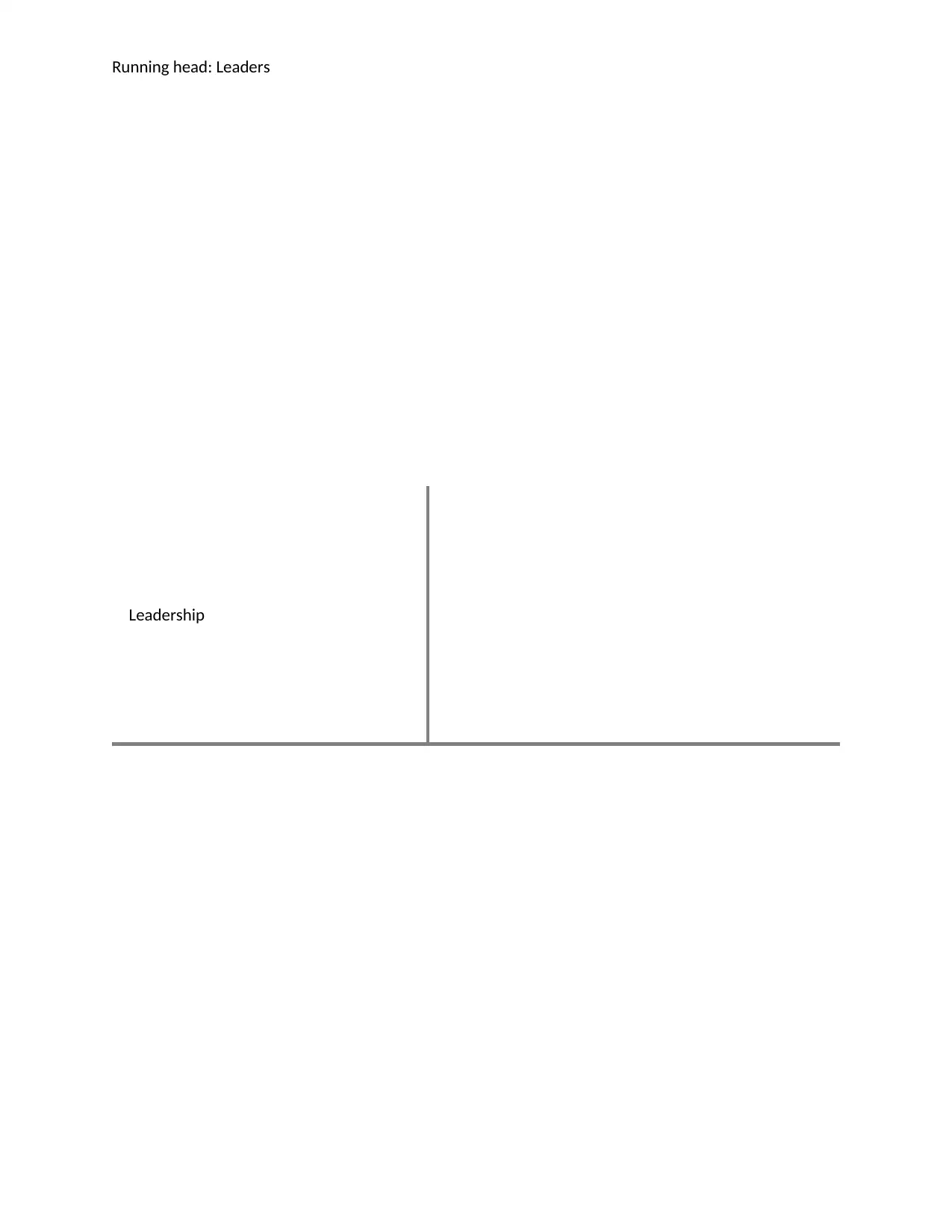
Running head: Leaders
Leadership
Leadership
Paraphrase This Document
Need a fresh take? Get an instant paraphrase of this document with our AI Paraphraser
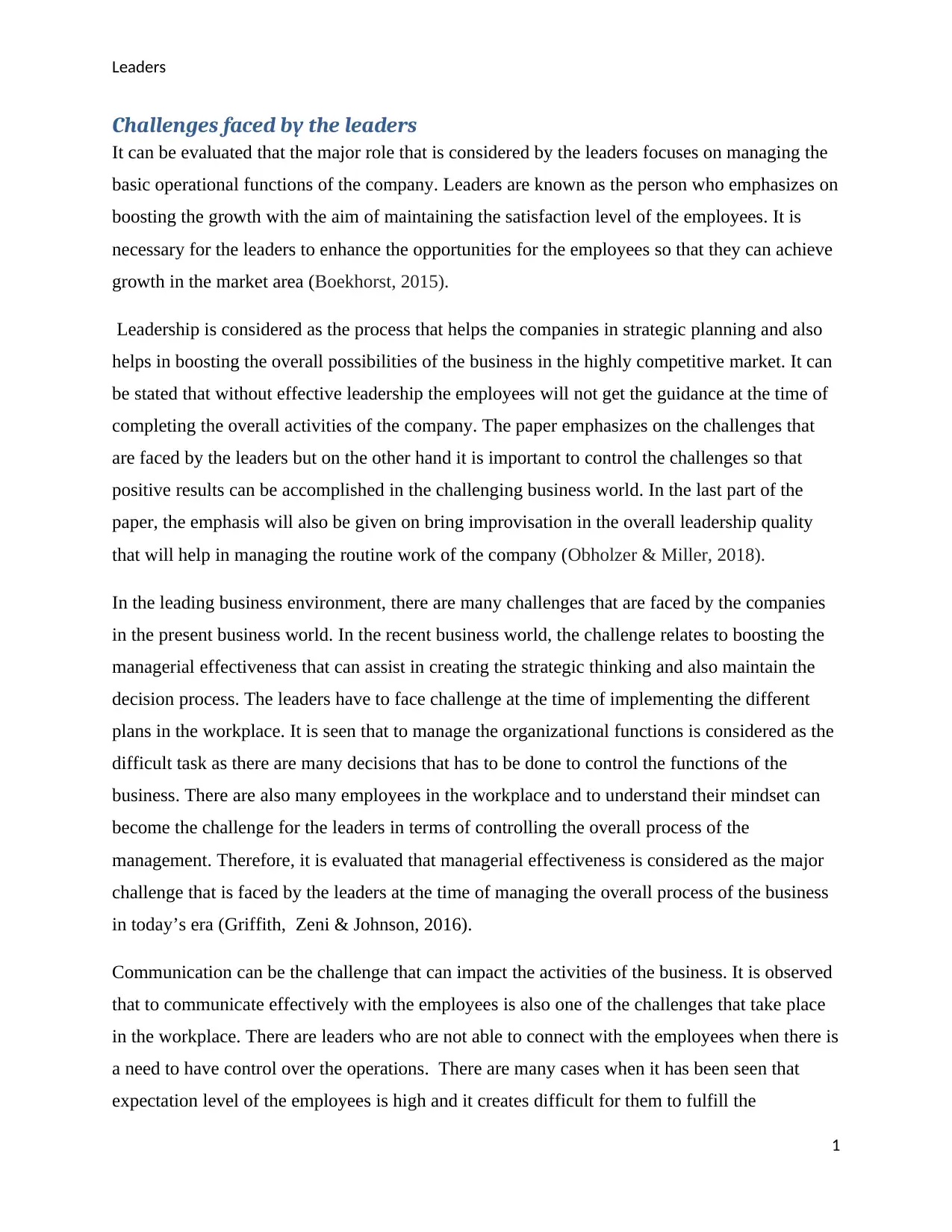
Leaders
Challenges faced by the leaders
It can be evaluated that the major role that is considered by the leaders focuses on managing the
basic operational functions of the company. Leaders are known as the person who emphasizes on
boosting the growth with the aim of maintaining the satisfaction level of the employees. It is
necessary for the leaders to enhance the opportunities for the employees so that they can achieve
growth in the market area (Boekhorst, 2015).
Leadership is considered as the process that helps the companies in strategic planning and also
helps in boosting the overall possibilities of the business in the highly competitive market. It can
be stated that without effective leadership the employees will not get the guidance at the time of
completing the overall activities of the company. The paper emphasizes on the challenges that
are faced by the leaders but on the other hand it is important to control the challenges so that
positive results can be accomplished in the challenging business world. In the last part of the
paper, the emphasis will also be given on bring improvisation in the overall leadership quality
that will help in managing the routine work of the company (Obholzer & Miller, 2018).
In the leading business environment, there are many challenges that are faced by the companies
in the present business world. In the recent business world, the challenge relates to boosting the
managerial effectiveness that can assist in creating the strategic thinking and also maintain the
decision process. The leaders have to face challenge at the time of implementing the different
plans in the workplace. It is seen that to manage the organizational functions is considered as the
difficult task as there are many decisions that has to be done to control the functions of the
business. There are also many employees in the workplace and to understand their mindset can
become the challenge for the leaders in terms of controlling the overall process of the
management. Therefore, it is evaluated that managerial effectiveness is considered as the major
challenge that is faced by the leaders at the time of managing the overall process of the business
in today’s era (Griffith, Zeni & Johnson, 2016).
Communication can be the challenge that can impact the activities of the business. It is observed
that to communicate effectively with the employees is also one of the challenges that take place
in the workplace. There are leaders who are not able to connect with the employees when there is
a need to have control over the operations. There are many cases when it has been seen that
expectation level of the employees is high and it creates difficult for them to fulfill the
1
Challenges faced by the leaders
It can be evaluated that the major role that is considered by the leaders focuses on managing the
basic operational functions of the company. Leaders are known as the person who emphasizes on
boosting the growth with the aim of maintaining the satisfaction level of the employees. It is
necessary for the leaders to enhance the opportunities for the employees so that they can achieve
growth in the market area (Boekhorst, 2015).
Leadership is considered as the process that helps the companies in strategic planning and also
helps in boosting the overall possibilities of the business in the highly competitive market. It can
be stated that without effective leadership the employees will not get the guidance at the time of
completing the overall activities of the company. The paper emphasizes on the challenges that
are faced by the leaders but on the other hand it is important to control the challenges so that
positive results can be accomplished in the challenging business world. In the last part of the
paper, the emphasis will also be given on bring improvisation in the overall leadership quality
that will help in managing the routine work of the company (Obholzer & Miller, 2018).
In the leading business environment, there are many challenges that are faced by the companies
in the present business world. In the recent business world, the challenge relates to boosting the
managerial effectiveness that can assist in creating the strategic thinking and also maintain the
decision process. The leaders have to face challenge at the time of implementing the different
plans in the workplace. It is seen that to manage the organizational functions is considered as the
difficult task as there are many decisions that has to be done to control the functions of the
business. There are also many employees in the workplace and to understand their mindset can
become the challenge for the leaders in terms of controlling the overall process of the
management. Therefore, it is evaluated that managerial effectiveness is considered as the major
challenge that is faced by the leaders at the time of managing the overall process of the business
in today’s era (Griffith, Zeni & Johnson, 2016).
Communication can be the challenge that can impact the activities of the business. It is observed
that to communicate effectively with the employees is also one of the challenges that take place
in the workplace. There are leaders who are not able to connect with the employees when there is
a need to have control over the operations. There are many cases when it has been seen that
expectation level of the employees is high and it creates difficult for them to fulfill the
1

Leaders
expectation level at the time of maintaining the operations. It can be seen that transparency is
also difficult to be maintained with the employees at the time of managing the strategies of the
organization. In this case, the leaders should emphasize on two way communication so that the
leaders can manage the overall challenge in the workplace. There are different backgrounds of
the people so to consider their views and opinions can be the challenge. So, to communicate
effectively it is important for the leaders to control the operations effectively (Harold & Holtz,
2015).
Change management is known as the challenge that is faced by the leaders in the present era. The
process of change is related with the standardized process that focuses on variant types of the
business environment. When the changes are made in the workplace, the leaders face the
challenge related with resistance to change from the employees. It creates difficulty for the
leaders to induce the employees to accept the change. In relation to this it is necessary for the
leaders to focus on considering the change management strategy so that employees can learn
about the change that is made by the management. It will also help in reducing the challenge that
relates with the change of the attitude towards the organizational activities (Harris & Jones,
2015).
The next challenge that is faced by the employees is concerned with motivating the employees in
the highly competitive business world. It is analyzed that to influence the other employees
mindset is one of the challenge for the leaders as they have to consider different techniques. In
the present era, it can be analyzed that it is one of the toughest job for the leaders to change the
mindset of the employees towards the assigned activities of the company. This challenge mainly
deals with inspiring and leading the team in the workplace. In the organization there are many
employees but they belong from different background an also have different mindset (Haynes
Hitt & Campbell, 2015).
To boost the employee’s motivation it is necessary for the leaders to emphasize on satisfying the
basic needs as it can be strategy that can assist in enhancing the level of motivation among the
employees. By examining the business environment, it can be said that employees have more
opportunities so it is difficult to motivate them by analyzing the today’s business world. It can be
stated that the challenges are important to be managed so that growth and also functioning of the
organization can be controlled in a proper manner (Afsar, Badir & Kiani, 2016).
2
expectation level at the time of maintaining the operations. It can be seen that transparency is
also difficult to be maintained with the employees at the time of managing the strategies of the
organization. In this case, the leaders should emphasize on two way communication so that the
leaders can manage the overall challenge in the workplace. There are different backgrounds of
the people so to consider their views and opinions can be the challenge. So, to communicate
effectively it is important for the leaders to control the operations effectively (Harold & Holtz,
2015).
Change management is known as the challenge that is faced by the leaders in the present era. The
process of change is related with the standardized process that focuses on variant types of the
business environment. When the changes are made in the workplace, the leaders face the
challenge related with resistance to change from the employees. It creates difficulty for the
leaders to induce the employees to accept the change. In relation to this it is necessary for the
leaders to focus on considering the change management strategy so that employees can learn
about the change that is made by the management. It will also help in reducing the challenge that
relates with the change of the attitude towards the organizational activities (Harris & Jones,
2015).
The next challenge that is faced by the employees is concerned with motivating the employees in
the highly competitive business world. It is analyzed that to influence the other employees
mindset is one of the challenge for the leaders as they have to consider different techniques. In
the present era, it can be analyzed that it is one of the toughest job for the leaders to change the
mindset of the employees towards the assigned activities of the company. This challenge mainly
deals with inspiring and leading the team in the workplace. In the organization there are many
employees but they belong from different background an also have different mindset (Haynes
Hitt & Campbell, 2015).
To boost the employee’s motivation it is necessary for the leaders to emphasize on satisfying the
basic needs as it can be strategy that can assist in enhancing the level of motivation among the
employees. By examining the business environment, it can be said that employees have more
opportunities so it is difficult to motivate them by analyzing the today’s business world. It can be
stated that the challenges are important to be managed so that growth and also functioning of the
organization can be controlled in a proper manner (Afsar, Badir & Kiani, 2016).
2
⊘ This is a preview!⊘
Do you want full access?
Subscribe today to unlock all pages.

Trusted by 1+ million students worldwide

Leaders
To handle the conflict is the challenge in which the leaders get confused and it creates difficulty
for them to consider the best solution. In the company if the conflicts are not managed
effectively then it can create dissatisfaction among the employees in the workplace. The
challenge focuses on creating and also implementing the formal process for managing the
conflicts. So, it can be stated that the challenge enhances among the leaders but it is important to
be managed effectively so that growth can be attained. The different employees have different
perceptions so to evaluate the best idea is one of the major challenges that create difficulty for
the workers in relation to manage the work in the today’s business world (Babalola, Stouten,
Euwema & Ovadje, 2018).
The challenges faced by leaders in the modern era are necessary to be addressed to make
sure that organizations are able to effective conduct their operations to maximize their
profitability. There are various changes which are necessary to be made in the way leadership is
framed and understand to meet those challenges (Van Wart, 2013). During complex and
uncertain times, it is important that these changes are implemented to achieve corporate goals by
enterprises which also assist them in achieving their corporate goals. The traditional approach of
leadership was focused on profit maximization goals, and the ability of the leader was assessed
based on the performance of the company.
In today’s era, the role of social responsibility of organizations has increased, and leaders
are expected to make sure that they implement effective policies that are targeted towards
creating a positive impact on society rather than solely focusing on profit maximization (Shuck
& Herd, 2012). Since leaders are responsible for forming business strategies and take decisions
on behalf of the enterprise, they are responsible for showing the direction to the company
(Kaiser, McGinnis & Overfield, 2012). The perception regarding leadership should be changed
to understand other roles of leaders in the workplace. Currently, issues such as lack of
motivation, ineffective change management and non-availability of management effectiveness
are key factors that are affecting the profitability and performance of organizations and these
challenges should be addressed by making changes in the way leaders are perceived.
One of the key changes which are necessary to be made is relating to the behavior of
leaders. Many successful leaders such as Bill Gates and Tim Cook has shown that they can
successfully lead major organizations while also focusing on the interest of a diverse range of
3
To handle the conflict is the challenge in which the leaders get confused and it creates difficulty
for them to consider the best solution. In the company if the conflicts are not managed
effectively then it can create dissatisfaction among the employees in the workplace. The
challenge focuses on creating and also implementing the formal process for managing the
conflicts. So, it can be stated that the challenge enhances among the leaders but it is important to
be managed effectively so that growth can be attained. The different employees have different
perceptions so to evaluate the best idea is one of the major challenges that create difficulty for
the workers in relation to manage the work in the today’s business world (Babalola, Stouten,
Euwema & Ovadje, 2018).
The challenges faced by leaders in the modern era are necessary to be addressed to make
sure that organizations are able to effective conduct their operations to maximize their
profitability. There are various changes which are necessary to be made in the way leadership is
framed and understand to meet those challenges (Van Wart, 2013). During complex and
uncertain times, it is important that these changes are implemented to achieve corporate goals by
enterprises which also assist them in achieving their corporate goals. The traditional approach of
leadership was focused on profit maximization goals, and the ability of the leader was assessed
based on the performance of the company.
In today’s era, the role of social responsibility of organizations has increased, and leaders
are expected to make sure that they implement effective policies that are targeted towards
creating a positive impact on society rather than solely focusing on profit maximization (Shuck
& Herd, 2012). Since leaders are responsible for forming business strategies and take decisions
on behalf of the enterprise, they are responsible for showing the direction to the company
(Kaiser, McGinnis & Overfield, 2012). The perception regarding leadership should be changed
to understand other roles of leaders in the workplace. Currently, issues such as lack of
motivation, ineffective change management and non-availability of management effectiveness
are key factors that are affecting the profitability and performance of organizations and these
challenges should be addressed by making changes in the way leaders are perceived.
One of the key changes which are necessary to be made is relating to the behavior of
leaders. Many successful leaders such as Bill Gates and Tim Cook has shown that they can
successfully lead major organizations while also focusing on the interest of a diverse range of
3
Paraphrase This Document
Need a fresh take? Get an instant paraphrase of this document with our AI Paraphraser
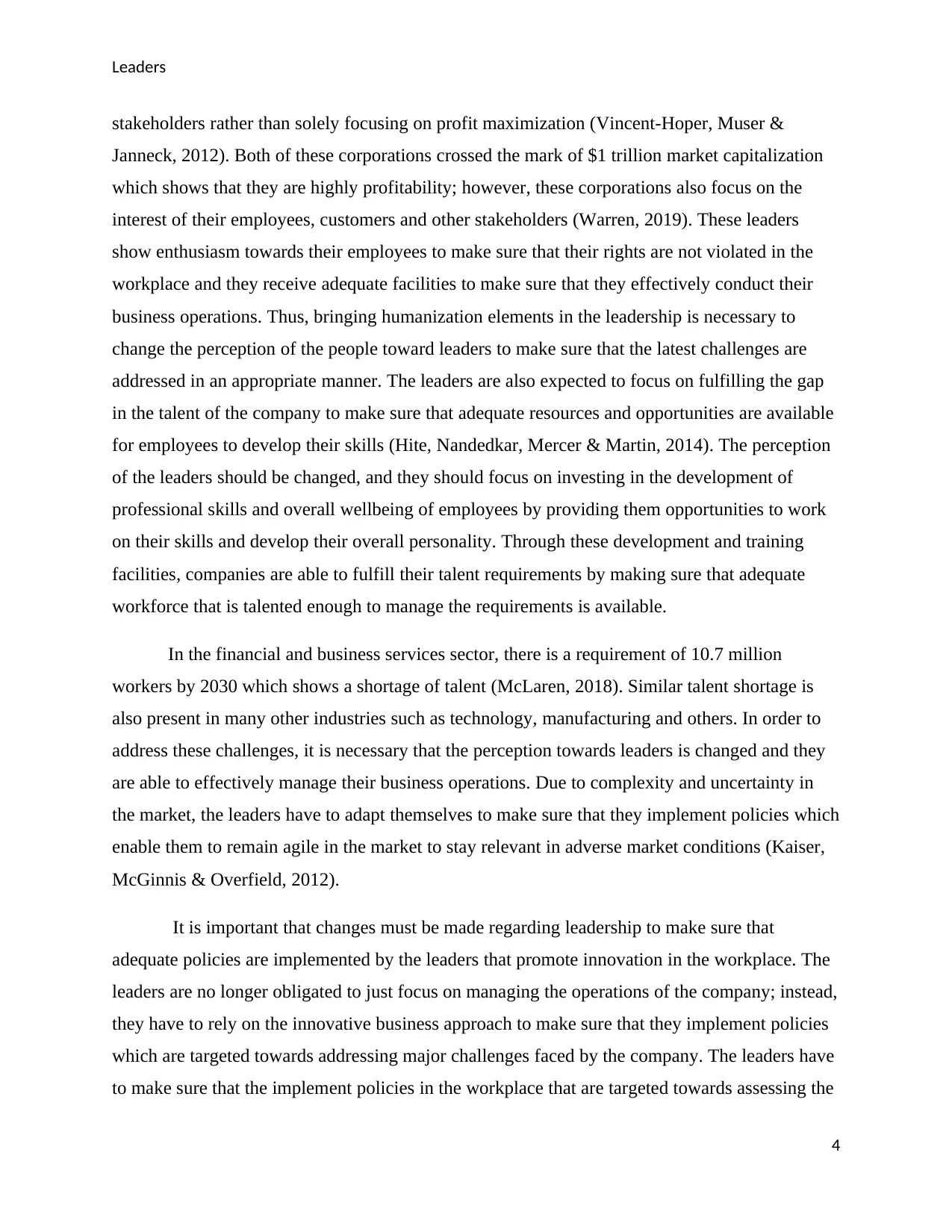
Leaders
stakeholders rather than solely focusing on profit maximization (Vincent-Hoper, Muser &
Janneck, 2012). Both of these corporations crossed the mark of $1 trillion market capitalization
which shows that they are highly profitability; however, these corporations also focus on the
interest of their employees, customers and other stakeholders (Warren, 2019). These leaders
show enthusiasm towards their employees to make sure that their rights are not violated in the
workplace and they receive adequate facilities to make sure that they effectively conduct their
business operations. Thus, bringing humanization elements in the leadership is necessary to
change the perception of the people toward leaders to make sure that the latest challenges are
addressed in an appropriate manner. The leaders are also expected to focus on fulfilling the gap
in the talent of the company to make sure that adequate resources and opportunities are available
for employees to develop their skills (Hite, Nandedkar, Mercer & Martin, 2014). The perception
of the leaders should be changed, and they should focus on investing in the development of
professional skills and overall wellbeing of employees by providing them opportunities to work
on their skills and develop their overall personality. Through these development and training
facilities, companies are able to fulfill their talent requirements by making sure that adequate
workforce that is talented enough to manage the requirements is available.
In the financial and business services sector, there is a requirement of 10.7 million
workers by 2030 which shows a shortage of talent (McLaren, 2018). Similar talent shortage is
also present in many other industries such as technology, manufacturing and others. In order to
address these challenges, it is necessary that the perception towards leaders is changed and they
are able to effectively manage their business operations. Due to complexity and uncertainty in
the market, the leaders have to adapt themselves to make sure that they implement policies which
enable them to remain agile in the market to stay relevant in adverse market conditions (Kaiser,
McGinnis & Overfield, 2012).
It is important that changes must be made regarding leadership to make sure that
adequate policies are implemented by the leaders that promote innovation in the workplace. The
leaders are no longer obligated to just focus on managing the operations of the company; instead,
they have to rely on the innovative business approach to make sure that they implement policies
which are targeted towards addressing major challenges faced by the company. The leaders have
to make sure that the implement policies in the workplace that are targeted towards assessing the
4
stakeholders rather than solely focusing on profit maximization (Vincent-Hoper, Muser &
Janneck, 2012). Both of these corporations crossed the mark of $1 trillion market capitalization
which shows that they are highly profitability; however, these corporations also focus on the
interest of their employees, customers and other stakeholders (Warren, 2019). These leaders
show enthusiasm towards their employees to make sure that their rights are not violated in the
workplace and they receive adequate facilities to make sure that they effectively conduct their
business operations. Thus, bringing humanization elements in the leadership is necessary to
change the perception of the people toward leaders to make sure that the latest challenges are
addressed in an appropriate manner. The leaders are also expected to focus on fulfilling the gap
in the talent of the company to make sure that adequate resources and opportunities are available
for employees to develop their skills (Hite, Nandedkar, Mercer & Martin, 2014). The perception
of the leaders should be changed, and they should focus on investing in the development of
professional skills and overall wellbeing of employees by providing them opportunities to work
on their skills and develop their overall personality. Through these development and training
facilities, companies are able to fulfill their talent requirements by making sure that adequate
workforce that is talented enough to manage the requirements is available.
In the financial and business services sector, there is a requirement of 10.7 million
workers by 2030 which shows a shortage of talent (McLaren, 2018). Similar talent shortage is
also present in many other industries such as technology, manufacturing and others. In order to
address these challenges, it is necessary that the perception towards leaders is changed and they
are able to effectively manage their business operations. Due to complexity and uncertainty in
the market, the leaders have to adapt themselves to make sure that they implement policies which
enable them to remain agile in the market to stay relevant in adverse market conditions (Kaiser,
McGinnis & Overfield, 2012).
It is important that changes must be made regarding leadership to make sure that
adequate policies are implemented by the leaders that promote innovation in the workplace. The
leaders are no longer obligated to just focus on managing the operations of the company; instead,
they have to rely on the innovative business approach to make sure that they implement policies
which are targeted towards addressing major challenges faced by the company. The leaders have
to make sure that the implement policies in the workplace that are targeted towards assessing the
4
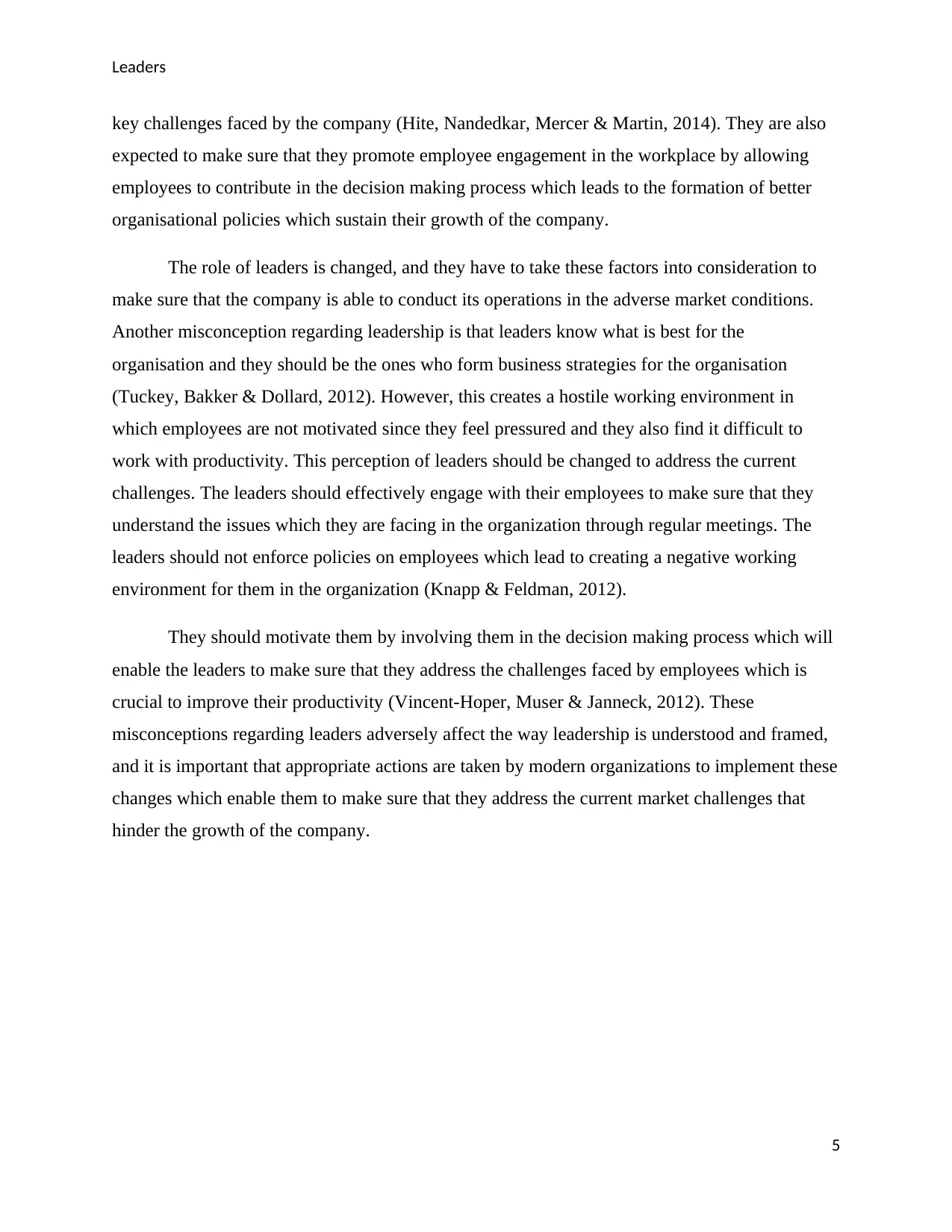
Leaders
key challenges faced by the company (Hite, Nandedkar, Mercer & Martin, 2014). They are also
expected to make sure that they promote employee engagement in the workplace by allowing
employees to contribute in the decision making process which leads to the formation of better
organisational policies which sustain their growth of the company.
The role of leaders is changed, and they have to take these factors into consideration to
make sure that the company is able to conduct its operations in the adverse market conditions.
Another misconception regarding leadership is that leaders know what is best for the
organisation and they should be the ones who form business strategies for the organisation
(Tuckey, Bakker & Dollard, 2012). However, this creates a hostile working environment in
which employees are not motivated since they feel pressured and they also find it difficult to
work with productivity. This perception of leaders should be changed to address the current
challenges. The leaders should effectively engage with their employees to make sure that they
understand the issues which they are facing in the organization through regular meetings. The
leaders should not enforce policies on employees which lead to creating a negative working
environment for them in the organization (Knapp & Feldman, 2012).
They should motivate them by involving them in the decision making process which will
enable the leaders to make sure that they address the challenges faced by employees which is
crucial to improve their productivity (Vincent-Hoper, Muser & Janneck, 2012). These
misconceptions regarding leaders adversely affect the way leadership is understood and framed,
and it is important that appropriate actions are taken by modern organizations to implement these
changes which enable them to make sure that they address the current market challenges that
hinder the growth of the company.
5
key challenges faced by the company (Hite, Nandedkar, Mercer & Martin, 2014). They are also
expected to make sure that they promote employee engagement in the workplace by allowing
employees to contribute in the decision making process which leads to the formation of better
organisational policies which sustain their growth of the company.
The role of leaders is changed, and they have to take these factors into consideration to
make sure that the company is able to conduct its operations in the adverse market conditions.
Another misconception regarding leadership is that leaders know what is best for the
organisation and they should be the ones who form business strategies for the organisation
(Tuckey, Bakker & Dollard, 2012). However, this creates a hostile working environment in
which employees are not motivated since they feel pressured and they also find it difficult to
work with productivity. This perception of leaders should be changed to address the current
challenges. The leaders should effectively engage with their employees to make sure that they
understand the issues which they are facing in the organization through regular meetings. The
leaders should not enforce policies on employees which lead to creating a negative working
environment for them in the organization (Knapp & Feldman, 2012).
They should motivate them by involving them in the decision making process which will
enable the leaders to make sure that they address the challenges faced by employees which is
crucial to improve their productivity (Vincent-Hoper, Muser & Janneck, 2012). These
misconceptions regarding leaders adversely affect the way leadership is understood and framed,
and it is important that appropriate actions are taken by modern organizations to implement these
changes which enable them to make sure that they address the current market challenges that
hinder the growth of the company.
5
⊘ This is a preview!⊘
Do you want full access?
Subscribe today to unlock all pages.

Trusted by 1+ million students worldwide

Leaders
By analyzing the challenges it is recommended that it is important for the leaders to be
disciplined towards the work. If discipline is not maintained by the leaders then the challenge
may arise related with inspiring the workers. The leaders should be disciplined so that it could be
easy to inspire the employees and also it will assist in motivating the employees. If the leaders
are disciplined then it will be easy to meet the deadlines of the activities. The discipline can be
maintained by the leaders if they emphasize on conducting the meetings on the regular basis. If
the meetings are conducted on frequent basis then it will help in considering the views and
opinions of the employees and it will help in reducing the challenge related to resistance of the
employees. It can be stated that if views are taken into consideration the leaders can solve it in an
effective manner and it will also help in boosting the motivational level of the employees
towards the assigned work (Heifetz & Linsky, 2017).
To lead the team is also the challenge for the leaders so that it can be controlled if focus is given
on considering the basic needs of the workers. The leaders should consider the decision making
skills in which they should emphasize on considering the right decision which is beneficial in
managing the operations of the business. The different requirements should also be met by the
leaders so that employee’s retention can take place in the workplace. In relation to this, the
leadership traits on which the emphasis should be given is emotional stability (Herman, 2016).
This is the best approach that can focus on managing the operations and also develop the leaders
and their leadership. It is important for the leaders to have the capability of managing the stress
in the workplace as it assists them to focus on the challenges that are faced by the employees. It
is necessary to focus on controlling the operations that are necessary to be considered so that the
outcome which is attained after that is positive.
It can be analyzed that enthusiasm is also the leadership trait that should be considered by the
leaders as it helps the leaders to be active and also focuses on being expressive and energetic. It
is stated that it is important for the leaders to be optimistic and open so that the emphasis can be
given on managing the difficult situations. This is one of the best ways that can help boosting the
leadership and the leaders in the highly competitive market. It is important to manage the
activities of the organization by emphasizing on this leadership trait. It can assist in motivating
the employees to be efficient towards the work and also it creates long term relation with the
6
By analyzing the challenges it is recommended that it is important for the leaders to be
disciplined towards the work. If discipline is not maintained by the leaders then the challenge
may arise related with inspiring the workers. The leaders should be disciplined so that it could be
easy to inspire the employees and also it will assist in motivating the employees. If the leaders
are disciplined then it will be easy to meet the deadlines of the activities. The discipline can be
maintained by the leaders if they emphasize on conducting the meetings on the regular basis. If
the meetings are conducted on frequent basis then it will help in considering the views and
opinions of the employees and it will help in reducing the challenge related to resistance of the
employees. It can be stated that if views are taken into consideration the leaders can solve it in an
effective manner and it will also help in boosting the motivational level of the employees
towards the assigned work (Heifetz & Linsky, 2017).
To lead the team is also the challenge for the leaders so that it can be controlled if focus is given
on considering the basic needs of the workers. The leaders should consider the decision making
skills in which they should emphasize on considering the right decision which is beneficial in
managing the operations of the business. The different requirements should also be met by the
leaders so that employee’s retention can take place in the workplace. In relation to this, the
leadership traits on which the emphasis should be given is emotional stability (Herman, 2016).
This is the best approach that can focus on managing the operations and also develop the leaders
and their leadership. It is important for the leaders to have the capability of managing the stress
in the workplace as it assists them to focus on the challenges that are faced by the employees. It
is necessary to focus on controlling the operations that are necessary to be considered so that the
outcome which is attained after that is positive.
It can be analyzed that enthusiasm is also the leadership trait that should be considered by the
leaders as it helps the leaders to be active and also focuses on being expressive and energetic. It
is stated that it is important for the leaders to be optimistic and open so that the emphasis can be
given on managing the difficult situations. This is one of the best ways that can help boosting the
leadership and the leaders in the highly competitive market. It is important to manage the
activities of the organization by emphasizing on this leadership trait. It can assist in motivating
the employees to be efficient towards the work and also it creates long term relation with the
6
Paraphrase This Document
Need a fresh take? Get an instant paraphrase of this document with our AI Paraphraser
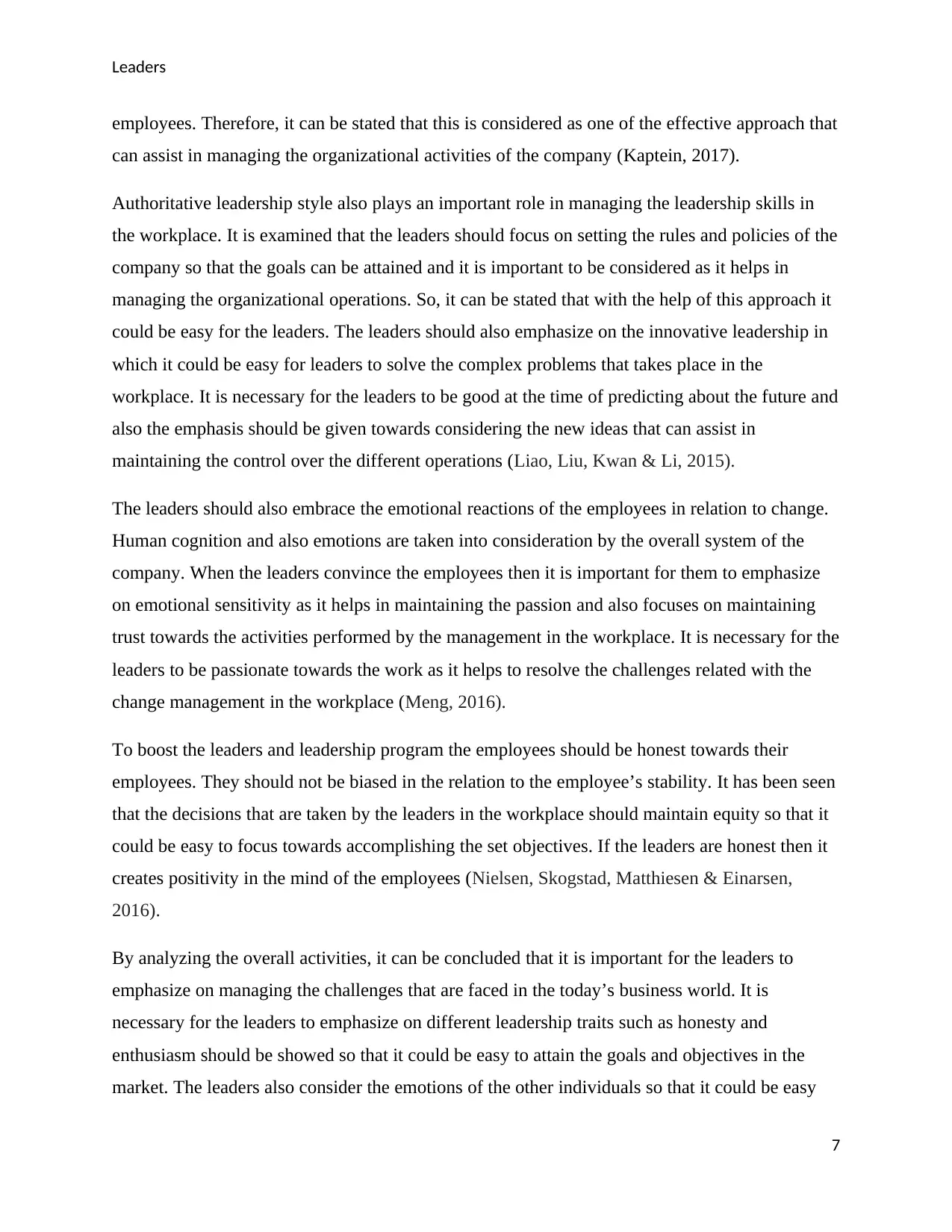
Leaders
employees. Therefore, it can be stated that this is considered as one of the effective approach that
can assist in managing the organizational activities of the company (Kaptein, 2017).
Authoritative leadership style also plays an important role in managing the leadership skills in
the workplace. It is examined that the leaders should focus on setting the rules and policies of the
company so that the goals can be attained and it is important to be considered as it helps in
managing the organizational operations. So, it can be stated that with the help of this approach it
could be easy for the leaders. The leaders should also emphasize on the innovative leadership in
which it could be easy for leaders to solve the complex problems that takes place in the
workplace. It is necessary for the leaders to be good at the time of predicting about the future and
also the emphasis should be given towards considering the new ideas that can assist in
maintaining the control over the different operations (Liao, Liu, Kwan & Li, 2015).
The leaders should also embrace the emotional reactions of the employees in relation to change.
Human cognition and also emotions are taken into consideration by the overall system of the
company. When the leaders convince the employees then it is important for them to emphasize
on emotional sensitivity as it helps in maintaining the passion and also focuses on maintaining
trust towards the activities performed by the management in the workplace. It is necessary for the
leaders to be passionate towards the work as it helps to resolve the challenges related with the
change management in the workplace (Meng, 2016).
To boost the leaders and leadership program the employees should be honest towards their
employees. They should not be biased in the relation to the employee’s stability. It has been seen
that the decisions that are taken by the leaders in the workplace should maintain equity so that it
could be easy to focus towards accomplishing the set objectives. If the leaders are honest then it
creates positivity in the mind of the employees (Nielsen, Skogstad, Matthiesen & Einarsen,
2016).
By analyzing the overall activities, it can be concluded that it is important for the leaders to
emphasize on managing the challenges that are faced in the today’s business world. It is
necessary for the leaders to emphasize on different leadership traits such as honesty and
enthusiasm should be showed so that it could be easy to attain the goals and objectives in the
market. The leaders also consider the emotions of the other individuals so that it could be easy
7
employees. Therefore, it can be stated that this is considered as one of the effective approach that
can assist in managing the organizational activities of the company (Kaptein, 2017).
Authoritative leadership style also plays an important role in managing the leadership skills in
the workplace. It is examined that the leaders should focus on setting the rules and policies of the
company so that the goals can be attained and it is important to be considered as it helps in
managing the organizational operations. So, it can be stated that with the help of this approach it
could be easy for the leaders. The leaders should also emphasize on the innovative leadership in
which it could be easy for leaders to solve the complex problems that takes place in the
workplace. It is necessary for the leaders to be good at the time of predicting about the future and
also the emphasis should be given towards considering the new ideas that can assist in
maintaining the control over the different operations (Liao, Liu, Kwan & Li, 2015).
The leaders should also embrace the emotional reactions of the employees in relation to change.
Human cognition and also emotions are taken into consideration by the overall system of the
company. When the leaders convince the employees then it is important for them to emphasize
on emotional sensitivity as it helps in maintaining the passion and also focuses on maintaining
trust towards the activities performed by the management in the workplace. It is necessary for the
leaders to be passionate towards the work as it helps to resolve the challenges related with the
change management in the workplace (Meng, 2016).
To boost the leaders and leadership program the employees should be honest towards their
employees. They should not be biased in the relation to the employee’s stability. It has been seen
that the decisions that are taken by the leaders in the workplace should maintain equity so that it
could be easy to focus towards accomplishing the set objectives. If the leaders are honest then it
creates positivity in the mind of the employees (Nielsen, Skogstad, Matthiesen & Einarsen,
2016).
By analyzing the overall activities, it can be concluded that it is important for the leaders to
emphasize on managing the challenges that are faced in the today’s business world. It is
necessary for the leaders to emphasize on different leadership traits such as honesty and
enthusiasm should be showed so that it could be easy to attain the goals and objectives in the
market. The leaders also consider the emotions of the other individuals so that it could be easy
7
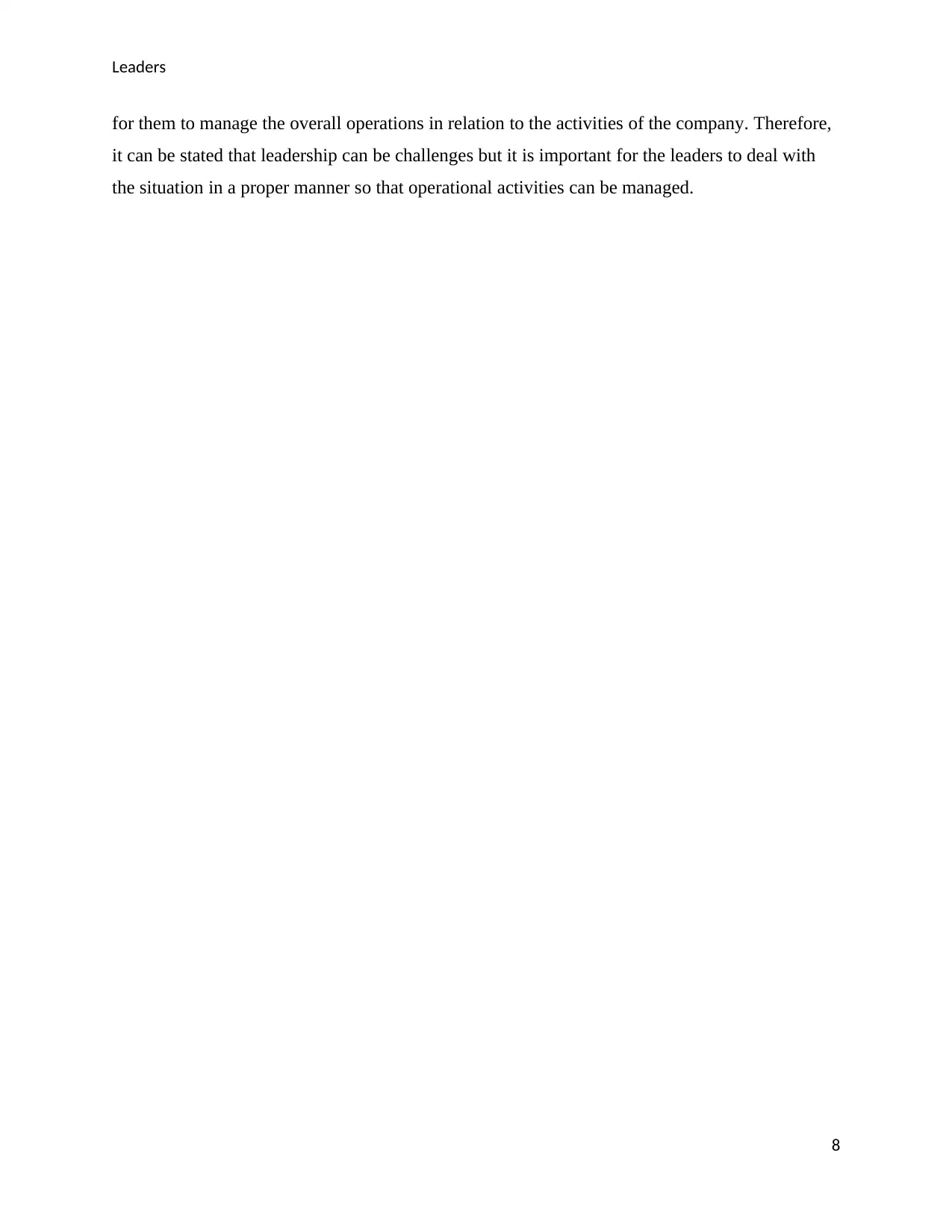
Leaders
for them to manage the overall operations in relation to the activities of the company. Therefore,
it can be stated that leadership can be challenges but it is important for the leaders to deal with
the situation in a proper manner so that operational activities can be managed.
8
for them to manage the overall operations in relation to the activities of the company. Therefore,
it can be stated that leadership can be challenges but it is important for the leaders to deal with
the situation in a proper manner so that operational activities can be managed.
8
⊘ This is a preview!⊘
Do you want full access?
Subscribe today to unlock all pages.

Trusted by 1+ million students worldwide
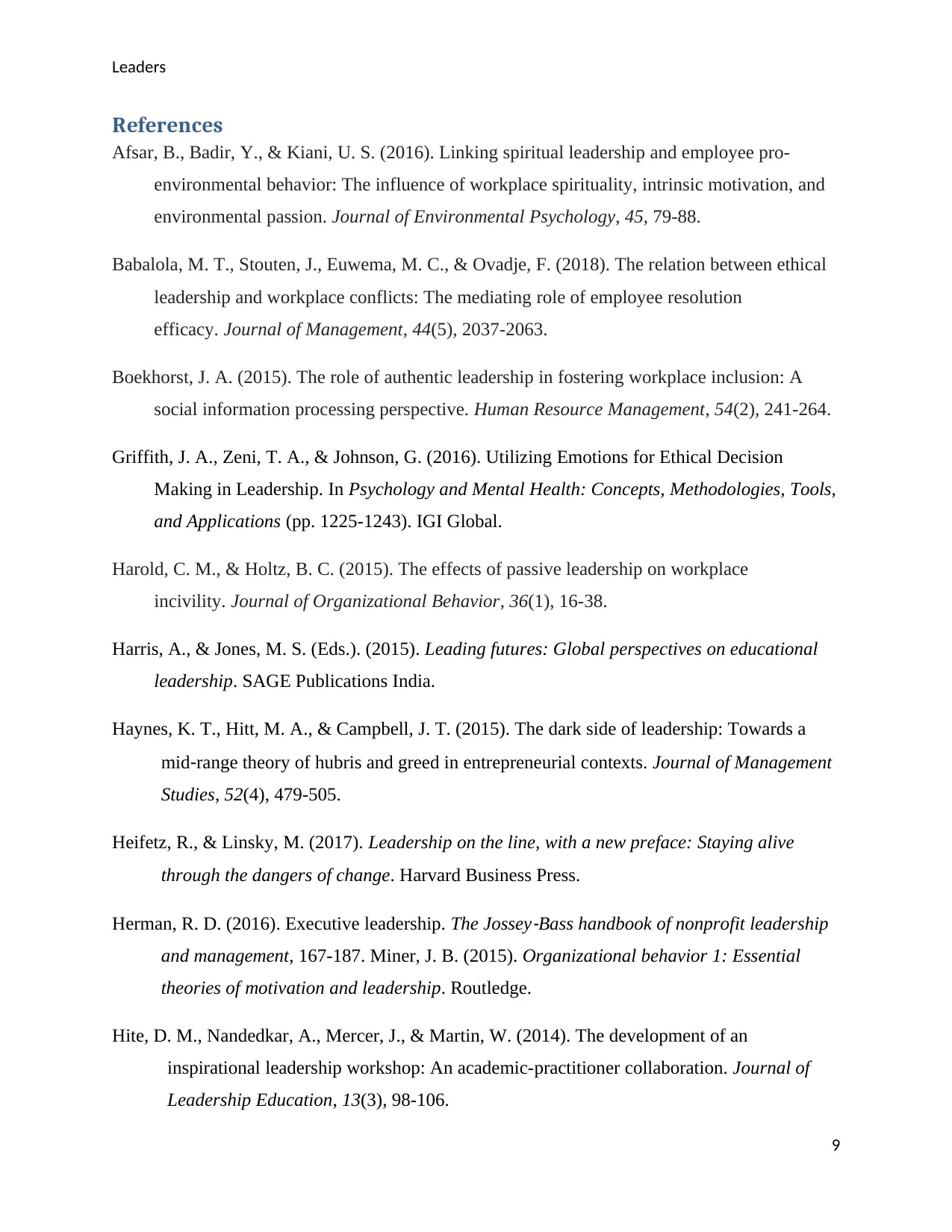
Leaders
References
Afsar, B., Badir, Y., & Kiani, U. S. (2016). Linking spiritual leadership and employee pro-
environmental behavior: The influence of workplace spirituality, intrinsic motivation, and
environmental passion. Journal of Environmental Psychology, 45, 79-88.
Babalola, M. T., Stouten, J., Euwema, M. C., & Ovadje, F. (2018). The relation between ethical
leadership and workplace conflicts: The mediating role of employee resolution
efficacy. Journal of Management, 44(5), 2037-2063.
Boekhorst, J. A. (2015). The role of authentic leadership in fostering workplace inclusion: A
social information processing perspective. Human Resource Management, 54(2), 241-264.
Griffith, J. A., Zeni, T. A., & Johnson, G. (2016). Utilizing Emotions for Ethical Decision
Making in Leadership. In Psychology and Mental Health: Concepts, Methodologies, Tools,
and Applications (pp. 1225-1243). IGI Global.
Harold, C. M., & Holtz, B. C. (2015). The effects of passive leadership on workplace
incivility. Journal of Organizational Behavior, 36(1), 16-38.
Harris, A., & Jones, M. S. (Eds.). (2015). Leading futures: Global perspectives on educational
leadership. SAGE Publications India.
Haynes, K. T., Hitt, M. A., & Campbell, J. T. (2015). The dark side of leadership: Towards a
mid‐range theory of hubris and greed in entrepreneurial contexts. Journal of Management
Studies, 52(4), 479-505.
Heifetz, R., & Linsky, M. (2017). Leadership on the line, with a new preface: Staying alive
through the dangers of change. Harvard Business Press.
Herman, R. D. (2016). Executive leadership. The Jossey
‐Bass handbook of nonprofit leadership
and management, 167-187. Miner, J. B. (2015). Organizational behavior 1: Essential
theories of motivation and leadership. Routledge.
Hite, D. M., Nandedkar, A., Mercer, J., & Martin, W. (2014). The development of an
inspirational leadership workshop: An academic-practitioner collaboration. Journal of
Leadership Education, 13(3), 98-106.
9
References
Afsar, B., Badir, Y., & Kiani, U. S. (2016). Linking spiritual leadership and employee pro-
environmental behavior: The influence of workplace spirituality, intrinsic motivation, and
environmental passion. Journal of Environmental Psychology, 45, 79-88.
Babalola, M. T., Stouten, J., Euwema, M. C., & Ovadje, F. (2018). The relation between ethical
leadership and workplace conflicts: The mediating role of employee resolution
efficacy. Journal of Management, 44(5), 2037-2063.
Boekhorst, J. A. (2015). The role of authentic leadership in fostering workplace inclusion: A
social information processing perspective. Human Resource Management, 54(2), 241-264.
Griffith, J. A., Zeni, T. A., & Johnson, G. (2016). Utilizing Emotions for Ethical Decision
Making in Leadership. In Psychology and Mental Health: Concepts, Methodologies, Tools,
and Applications (pp. 1225-1243). IGI Global.
Harold, C. M., & Holtz, B. C. (2015). The effects of passive leadership on workplace
incivility. Journal of Organizational Behavior, 36(1), 16-38.
Harris, A., & Jones, M. S. (Eds.). (2015). Leading futures: Global perspectives on educational
leadership. SAGE Publications India.
Haynes, K. T., Hitt, M. A., & Campbell, J. T. (2015). The dark side of leadership: Towards a
mid‐range theory of hubris and greed in entrepreneurial contexts. Journal of Management
Studies, 52(4), 479-505.
Heifetz, R., & Linsky, M. (2017). Leadership on the line, with a new preface: Staying alive
through the dangers of change. Harvard Business Press.
Herman, R. D. (2016). Executive leadership. The Jossey
‐Bass handbook of nonprofit leadership
and management, 167-187. Miner, J. B. (2015). Organizational behavior 1: Essential
theories of motivation and leadership. Routledge.
Hite, D. M., Nandedkar, A., Mercer, J., & Martin, W. (2014). The development of an
inspirational leadership workshop: An academic-practitioner collaboration. Journal of
Leadership Education, 13(3), 98-106.
9
Paraphrase This Document
Need a fresh take? Get an instant paraphrase of this document with our AI Paraphraser

Leaders
Kaiser, R. B., McGinnis, J. L., & Overfield, D. V. (2012). The how and the what of
leadership. Consulting Psychology Journal: Practice and Research, 64(2), 119.
Kaptein, M. (2017). The moral entrepreneur: A new component of ethical leadership. Journal of
Business Ethics, 1-16.
Knapp, M. S., & Feldman, S. B. (2012). Managing the intersection of internal and external
accountability: Challenge for urban school leadership in the United States. Journal of
Educational Administration, 50(5), 666-694.
Liao, Y., Liu, X. Y., Kwan, H. K., & Li, J. (2015). Work–family effects of ethical
leadership. Journal of Business Ethics, 128(3), 535-545.
McLaren, S. (2018). These Industries Will Face the Biggest Talent Shortages by 2030. Retrieved
from https://business.linkedin.com/talent-solutions/blog/trends-and-research/2018/
industries-biggest-talent-shortages-2030
Meng, Y. (2016). Spiritual leadership at the workplace: Perspectives and theories. Biomedical
reports, 5(4), 408-412.
Nielsen, M. B., Skogstad, A., Matthiesen, S. B., & Einarsen, S. (2016). The importance of a
multidimensional and temporal design in research on leadership and workplace safety. The
Leadership Quarterly, 27(1), 142-155.
Obholzer, A., & Miller, S. (2018). Leadership, followership, and facilitating the creative
workplace. In Working Below the Surface (pp. 33-48). Routledge.
Shuck, B., & Herd, A. M. (2012). Employee engagement and leadership: Exploring the
convergence of two frameworks and implications for leadership development in
HRD. Human resource development review, 11(2), 156-181.
Tuckey, M. R., Bakker, A. B., & Dollard, M. F. (2012). Empowering leaders optimize working
conditions for engagement: A multilevel study. Journal of occupational health
psychology, 17(1), 15.
10
Kaiser, R. B., McGinnis, J. L., & Overfield, D. V. (2012). The how and the what of
leadership. Consulting Psychology Journal: Practice and Research, 64(2), 119.
Kaptein, M. (2017). The moral entrepreneur: A new component of ethical leadership. Journal of
Business Ethics, 1-16.
Knapp, M. S., & Feldman, S. B. (2012). Managing the intersection of internal and external
accountability: Challenge for urban school leadership in the United States. Journal of
Educational Administration, 50(5), 666-694.
Liao, Y., Liu, X. Y., Kwan, H. K., & Li, J. (2015). Work–family effects of ethical
leadership. Journal of Business Ethics, 128(3), 535-545.
McLaren, S. (2018). These Industries Will Face the Biggest Talent Shortages by 2030. Retrieved
from https://business.linkedin.com/talent-solutions/blog/trends-and-research/2018/
industries-biggest-talent-shortages-2030
Meng, Y. (2016). Spiritual leadership at the workplace: Perspectives and theories. Biomedical
reports, 5(4), 408-412.
Nielsen, M. B., Skogstad, A., Matthiesen, S. B., & Einarsen, S. (2016). The importance of a
multidimensional and temporal design in research on leadership and workplace safety. The
Leadership Quarterly, 27(1), 142-155.
Obholzer, A., & Miller, S. (2018). Leadership, followership, and facilitating the creative
workplace. In Working Below the Surface (pp. 33-48). Routledge.
Shuck, B., & Herd, A. M. (2012). Employee engagement and leadership: Exploring the
convergence of two frameworks and implications for leadership development in
HRD. Human resource development review, 11(2), 156-181.
Tuckey, M. R., Bakker, A. B., & Dollard, M. F. (2012). Empowering leaders optimize working
conditions for engagement: A multilevel study. Journal of occupational health
psychology, 17(1), 15.
10
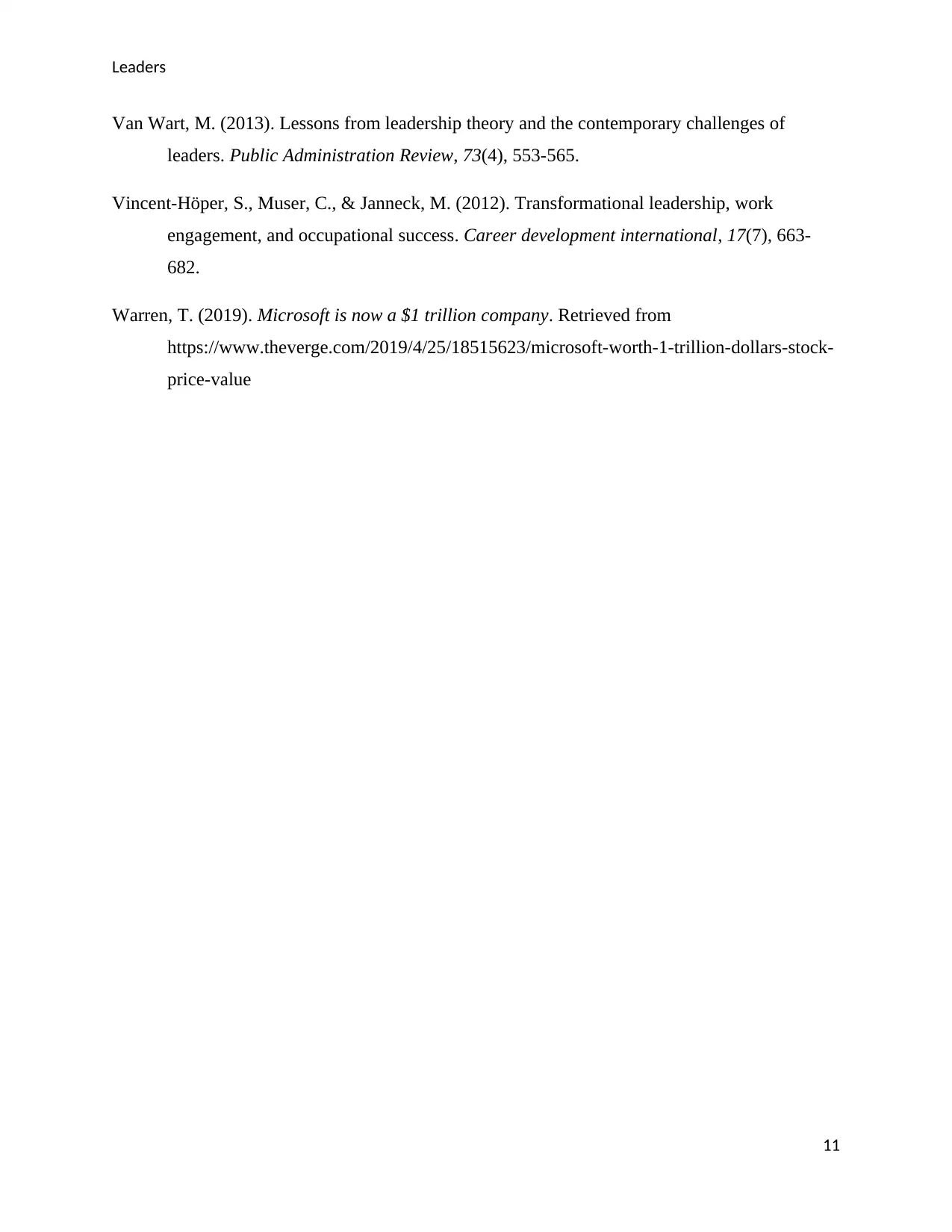
Leaders
Van Wart, M. (2013). Lessons from leadership theory and the contemporary challenges of
leaders. Public Administration Review, 73(4), 553-565.
Vincent-Höper, S., Muser, C., & Janneck, M. (2012). Transformational leadership, work
engagement, and occupational success. Career development international, 17(7), 663-
682.
Warren, T. (2019). Microsoft is now a $1 trillion company. Retrieved from
https://www.theverge.com/2019/4/25/18515623/microsoft-worth-1-trillion-dollars-stock-
price-value
11
Van Wart, M. (2013). Lessons from leadership theory and the contemporary challenges of
leaders. Public Administration Review, 73(4), 553-565.
Vincent-Höper, S., Muser, C., & Janneck, M. (2012). Transformational leadership, work
engagement, and occupational success. Career development international, 17(7), 663-
682.
Warren, T. (2019). Microsoft is now a $1 trillion company. Retrieved from
https://www.theverge.com/2019/4/25/18515623/microsoft-worth-1-trillion-dollars-stock-
price-value
11
⊘ This is a preview!⊘
Do you want full access?
Subscribe today to unlock all pages.

Trusted by 1+ million students worldwide
1 out of 12
Related Documents
Your All-in-One AI-Powered Toolkit for Academic Success.
+13062052269
info@desklib.com
Available 24*7 on WhatsApp / Email
![[object Object]](/_next/static/media/star-bottom.7253800d.svg)
Unlock your academic potential
Copyright © 2020–2025 A2Z Services. All Rights Reserved. Developed and managed by ZUCOL.





